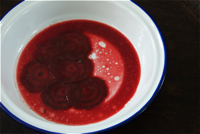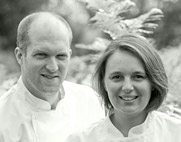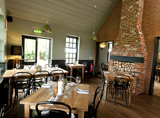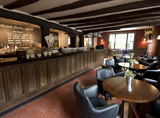Sautéed Wild Salmon with Macerated Beetroot
I can only describe this dish as healthy and sophisticated. The nuttiness of the wholesome pearl barley salad complements the fresh wild salmon. To add to the earthy taste I have added macerated beetroot. This dish is perfect to be served as a starter or as a light lunch.
John Campbell has been a great inspiration to me in my cooking, he is the voice of reason. I have spent a few days in Johns kitchen, we discussed lots of methods and techniques and this method of curing the fish before cooking was one of them. By curing the salmon in a solution of salt and sugar it draws the water from the salmon and tightens the flesh. The flesh of the salmon sticks together and does not fall apart when cooking. I use this method every time I prepare fish for cooking, just as John has taught me.
Interestingly the beetroot is not cooked, you might find that strange as beetroot is quite a dense and firm vegetable. By macerating the beetroot in a mixture of vinegar, sugar, oil and salt it softens the beetroot but retains the fresh earthy flavours.
Sautéed Wild Salmon
- 360g organic wild salmon
- 100g unrefined caster sugar
- 100g table salt
Remove the skin and pin bones from the salmon.
Cut the salmon in 30g pieces.
Mix the salt and sugar, coat the salmon with the mixture, and let the salmon cure for 15 minutes. Wash the salmon under cold running water and dry the salmon on clean kitchen paper.
The fish is now ready to be sautéed. Heat a non-stick frying pan with a tablespoon of olive oil, do not season the fish as it has absorbed the salt from the curing earlier on.
Sauté the salmon cubes until golden on all the sides, remember to place the presentation side down in to the pan first. Cook for 2 minutes on both sides, top and bottom.
Drain the salmon on kitchen paper.
Wholesome Pearl Barley and Beetroot Salad
- 300g pearl barley
- 50g toasted sunflower seeds
- 40g sugar snap peas
- 10g flat leaf parsley
- 40g spring onions
- salt and pepper
- 1tsp ground sumac
- 25ml olive oil
- 2tsp lemon juice
- zest of one lemon
Rinse the pearl barley under cold water, transfer the pearl barley to a large saucepan and cover the pearl barley with cold water, do not add any salt at this stage.
Bring to the boil, reduce the heat to a simmer and cook the pearl barley for approximately 20 minutes until soft but still holds it’s shape. Add salt right at the end of the cooking time.
Drain the pearl barley in a colander and rinse with cold water, let the pearl barley drain.
Place the pearl barley in a large mixing bowl, add the olive oil, seasoning, ground sumac, toasted sunflower seeds, lemon juice and zest.
Rough chop the parsley, slice the spring onions and sugar snap peas. Mix all the ingredients together, set-aside until serving.
 Macerated Beetroot
Macerated Beetroot
- 2 whole raw beetroot, peeled
- 25ml sherry vinegar
- 1tsp unrefined caster sugar
- 1tsp honey
- sprig of fresh thyme
- 1tbs olive oil
- course sea salt and freshly ground black pepper
The beetroot needs to marinade in the liquid for a minimum of 2 hours before using.
The vinegar and salt helps to break down and soften the beetroot, a form of pickling.
I normally do this a few days in advance and keep it in a clean airtight container in the fridge.
Peel the beetroot, use a mandolin to finely slice the raw beetroot about 1mm thick.
Mix the rest of the ingredients in a mixing bowl and add the raw sliced beetroot, be generous with the seasoning. Refrigerate for a minimum of 2 hours before using.
Assemble the dish:
Drain the beetroot on kitchen paper, place 9 pieces on each plate. Spoon on the pearl barley salad to make a small tower. Place the salmon on top of the beetroot and garnish with pea shoots or rocket. Serve three pieces of salmon per portion; finish garnishing the plate with olive oil and rocket.
Makes 4 starter portions
Print Recipe Print Recipe with Photo Email this Recipe






Fab recipes for espumas and thank you for your inspiration. Im a teacher and constantly striving to inspire chefs both in college and industry. A question which baffles me to date!!
Is there a specific ingredient/recipe which requires uses Co2 gas chargers and others which need Nitrous Oxide??
Regards
Dermot
Dear Dermot,
Thank you for your comment on the British Larder.
I wrote a small paragraph about Espuma Facts which hopefully answer your question:
Espuma facts:
* The liquid or puree must be thick to hold its shape. For the foam to hold its shape for a period of time there must be some form of thickening or gelling agent present in the liquid.
* For hot foam the best thickeners are fat or starch; this could be found in butter, cream or milk. It’s also important to make sure that the liquid is not too hot the perfect temperature is no higher than 65°C and no lower than 50°C. Place the cream whipper in a bain-marie filled with hot water; keep for no longer than 2 hours.
* Cold foams also require fat to stabilise the shape but if you make dairy free foams you can use gelatine alongside a thick liquid, to stabilise the foam. All depends on what it is that you are making but I normally use 1 leaf of gelatine to 250ml of thick liquid. If your choice is dairy you can add fat by adding yoghurt, crème fraîche or cream.
* There are two different gasses available to charge the cream whipper . Standard gas bulbs that will give you the foaming characteristics are Nitrous oxide (N2o) used in standard Cream Whippers.
* Carbon Dioxide (Co2) is also available and will give the liquid a fizzy texture commonly found in fizzy drinks. Select your gas carefully to give you the desired end result. If you would like to experiment with making fizzy soda drinks I recommend that you should investigate the Soda Syphons bottles.
Happy Cooking
Madalene
nice recipe, tried this one last night, went very well. highly recommended